by: Sascha Dueker, WPT Lovebird Conservation Coordinator
A new roadmap to boost lovebird conservation:
We received exciting news from the African Lovebird research front: the scientific conservation review paper (Dueker et al. 2023) has now been published by the leading South African journal Ostrich, which is a major step forward in the work being done for these charismatic birds in the wild. Writing the paper has ever been a priority by the Parrot Researchers Group (PRG) after the review on larger African parrots was published earlier (Martin et al. 2014).
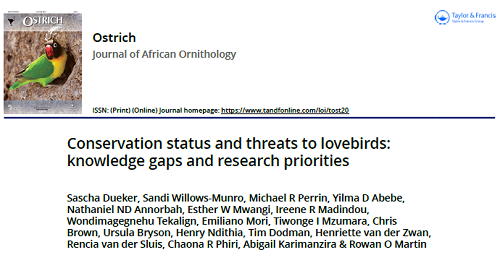
Read the paper online: https://doi.org/10.2989/00306525.2023.2206674
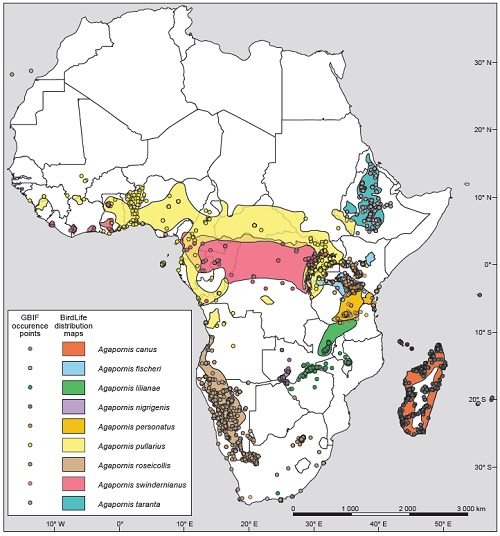
Fig. 1 showing the distribution of the 9 different lovebird species.
Lovebirds are a group of small, colourful parrots, two-thirds of which are considered to have declining populations, that are endemic to sub-Saharan Africa and Madagascar. This new scientific paper will provide a much-needed boost for the conservation and research of lovebirds highlighting the most important knowledge gaps. The paper combines expert knowledge with an extensive review of primary and grey literature to identify what is known and what we need to find out to better conserve this group of birds. The research highlighted how published studies were largely concentrated on lovebird populations in Southern Africa and, to a lesser extent, East Africa. As a result, many species remain poorly studied in the wild, including well-known companion lovebirds such as the Fischer’s Lovebird (Agapornis fischeri) and the Masked Lovebird (Agapornis personatus). For some species, such as the Black-collared Lovebird (A. swindernianus) there is a paucity of even basic information, such as geo-referenced records of presence in much of their presumed range.
The paper also considers what is known about threats in the wild, highlighting how lovebirds have historically been taken from the wild in large numbers for the international pet trade, leading to population declines. Although the trade in wild lovebirds has been greatly reduced compared to historical levels, considerable numbers are still being captured for local and international trade without any monitoring of the wild populations. In recent years Madagascar has issued permits to export thousands of wild Grey-headed lovebirds (A. canus) for commercial trade. Habitat change is also playing a role in population declines, particularly among species considered to be habitat specialists such as the Nyasa, or Lilian’s Lovebird (A. lilianae) and the Black-cheeked Lovebird (A. nigrigenis). However, changing habitat has also driven range expansions and, in combination with trade, has created numerous novel contact zones between species that were formerly divided by natural barriers such as vegetation. Hybridisation has been widely reported, particularly in East Africa, and studies on the implications of this for conservation are urgently needed.
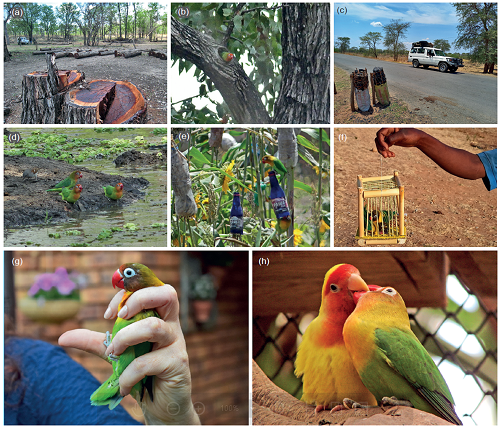
Fig. 2 (images a-h) showing different threats to lovebirds from logging of roosting and breeding trees over capture for the pet trade and hybridization.
The studies’ 19 authors who come from across the African continent and beyond call for more targeted research on lovebirds to inform assessments of their population trends, understand the drivers of these trends and highlight opportunities to leverage existing data and new research tools to advance knowledge to support their conservation. We hope this new scientific paper will be a significant step forward in understanding the conservation needs of lovebirds and be a catalyst for many new initiatives to help protect and preserve these special birds.
Reference
Sascha Dueker, Sandi Willows-Munro, Michael R Perrin, Yilma D Abebe, Nathaniel ND Annorbah, Esther W Mwangi, Ireene R Madindou, Wondimagegnehu Tekalign, Emiliano Mori, Tiwonge I Mzumara, Chris Brown, Ursula Bryson, Henry Ndithia, Tim Dodman, Henriette van der Zwan, Rencia van der Sluis, Chaona R Phiri, Abigail Karimanzira & Rowan O Martin (2023) Conservation status and threats to lovebirds: knowledge gaps and research priorities, Ostrich, 94:1, 1-27, DOI: 10.2989/00306525.2023.2206674
by: Sascha Dueker, WPT Lovebird Conservation Coordinator.
Over the last 3 years lovebird researchers and conservationists from across Africa have been working together to review the knowledge gaps and research priorities for the conservation of the lovebirds. This project was initiated by the Parrot Researcher’s Group, and the collaborative efforts have led to the production of a scientific paper recently accepted for publication in Africa’s leading ornithological journal Ostrich. One of the outcomes of this process has been the development of a community of researchers and conservationists concerned about the plight of lovebirds however many of us have never had the chance to meet in person. After two years of delays due to the Covid 19 pandemic the Pan African Ornithological Congress in Victoria Falls Zimbabwe provided just such an opportunity.
The Congress was the ideal venue to launch the key findings of the review and engage with leading researchers and conservationists about the plight of Africa’s lovebirds. WPT’s Lovebird Conservation coordinator Sascha Dueker presented the key findings of the review in the poster sessions alongside several of the review’s co-authors. An evening lovebird networking event, organised by Sascha, provided an opportunity for discussion and the forging of new friendships.
Victoria Falls lies close to the ranges of two of Africa’s most threatened lovebirds Black-cheeked and Nyasa (or Lilian’s) lovebirds and may have been home to the former in the recent past. These two species are endemic to the Mopane woodlands of the Zambezi River basin, a habitat which is under threat. Dr. Tiwonge Mzumara-Gawa of the Malawi University of Scientific and Technology and WPT’s Lovebird Research Officer coordinated a symposium on threats to Mopane Woodlands in the region with a particular focus on how lovebird populations can be supported.
These presentations, meetings, and discussions at the PAOC15 were an important step in raising awareness of the need for lovebird research and conservation, and in helping to build a network of passionate conservationists. We must all work together to ensure that lovebirds are protected and conserved for future generations.
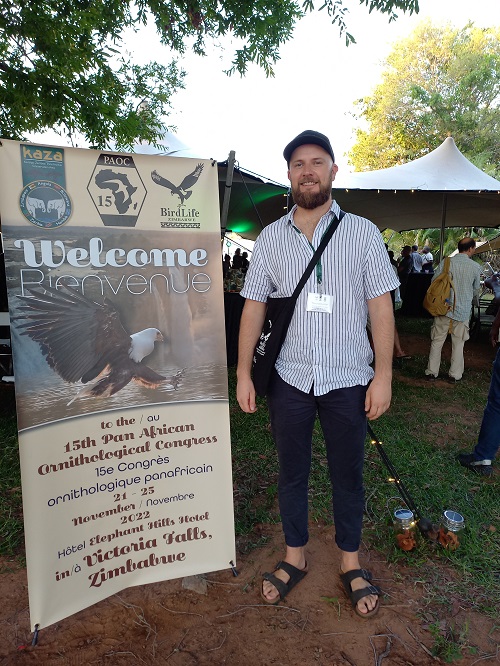
The PAOC15 opening ceremony was held at the bank of the Zambezi River in Victoria Falls, Zimbabwe. An opportunity for WPT Lovebird Conservation Coordinator Sascha Dueker to connect with lovebird researchers.
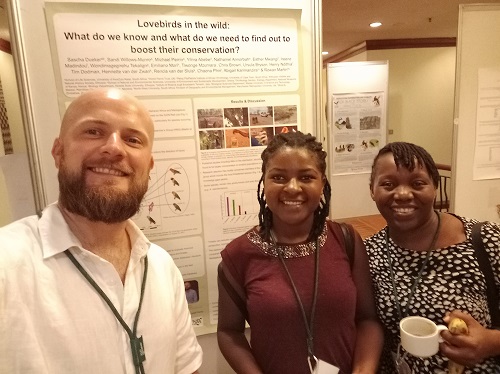
Sascha, Tamara, and Tiwonge presenting findings of the lovebird research and conservation review.

A fun and informal yet informative evening gathering for African lovebird researchers.

